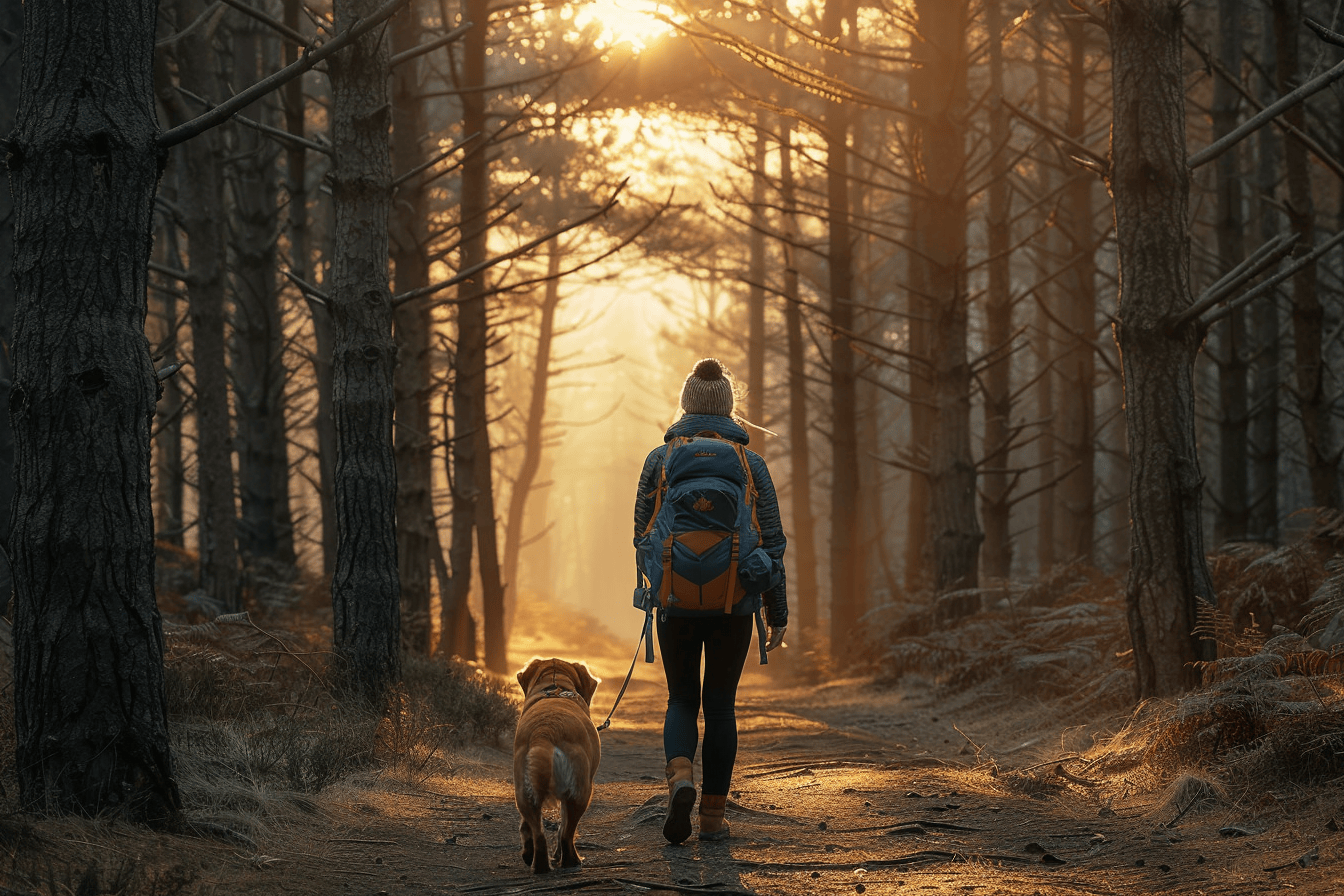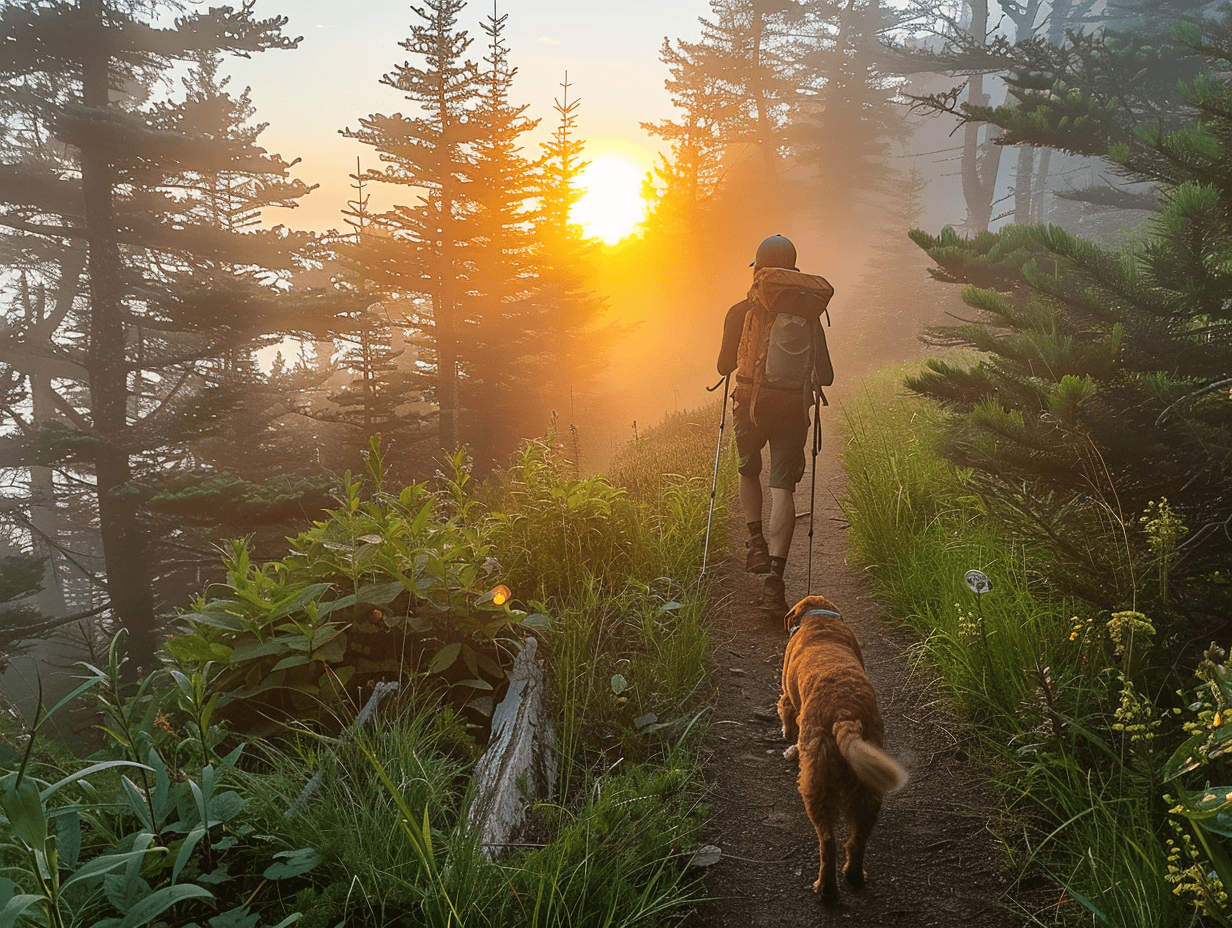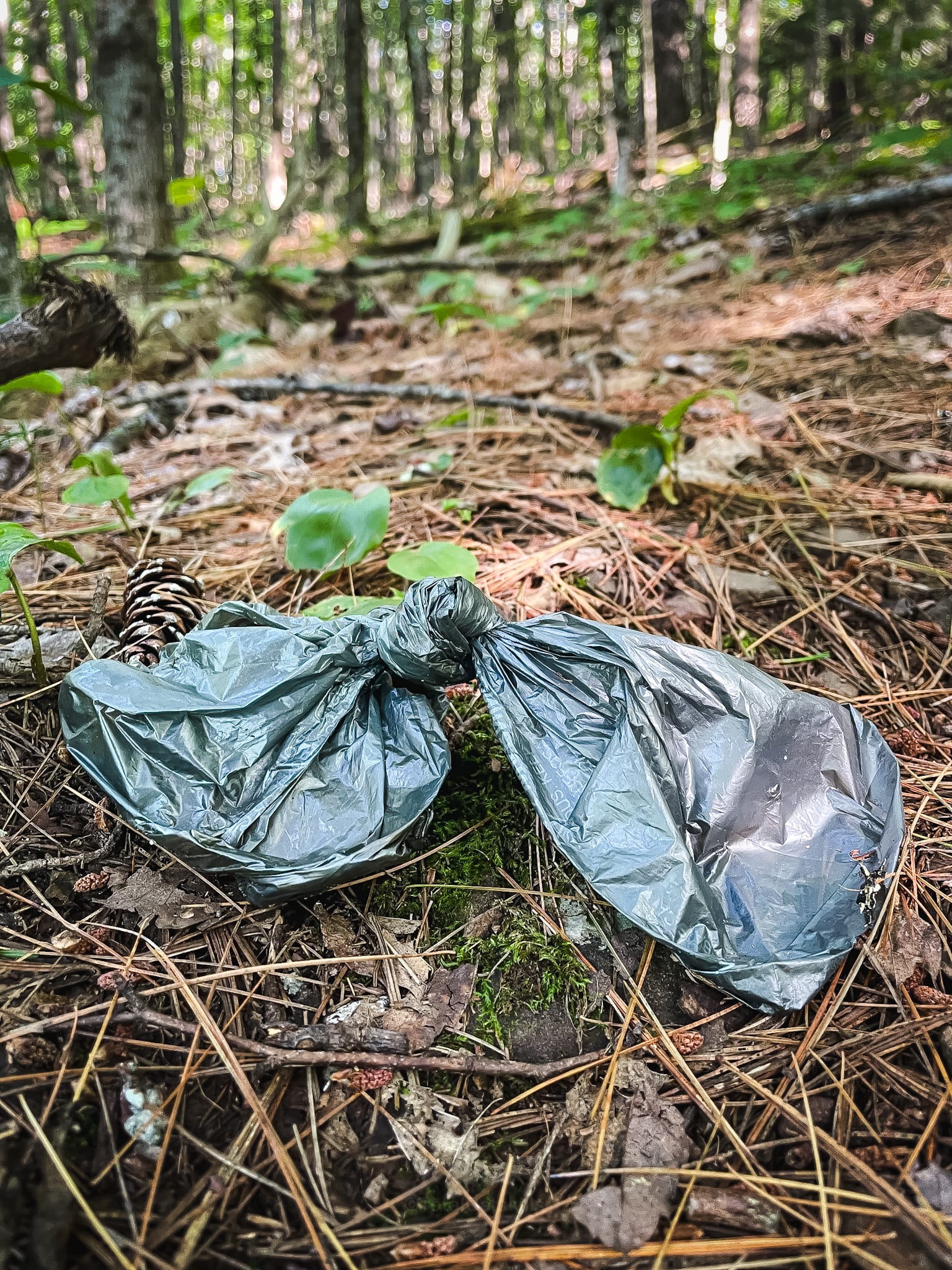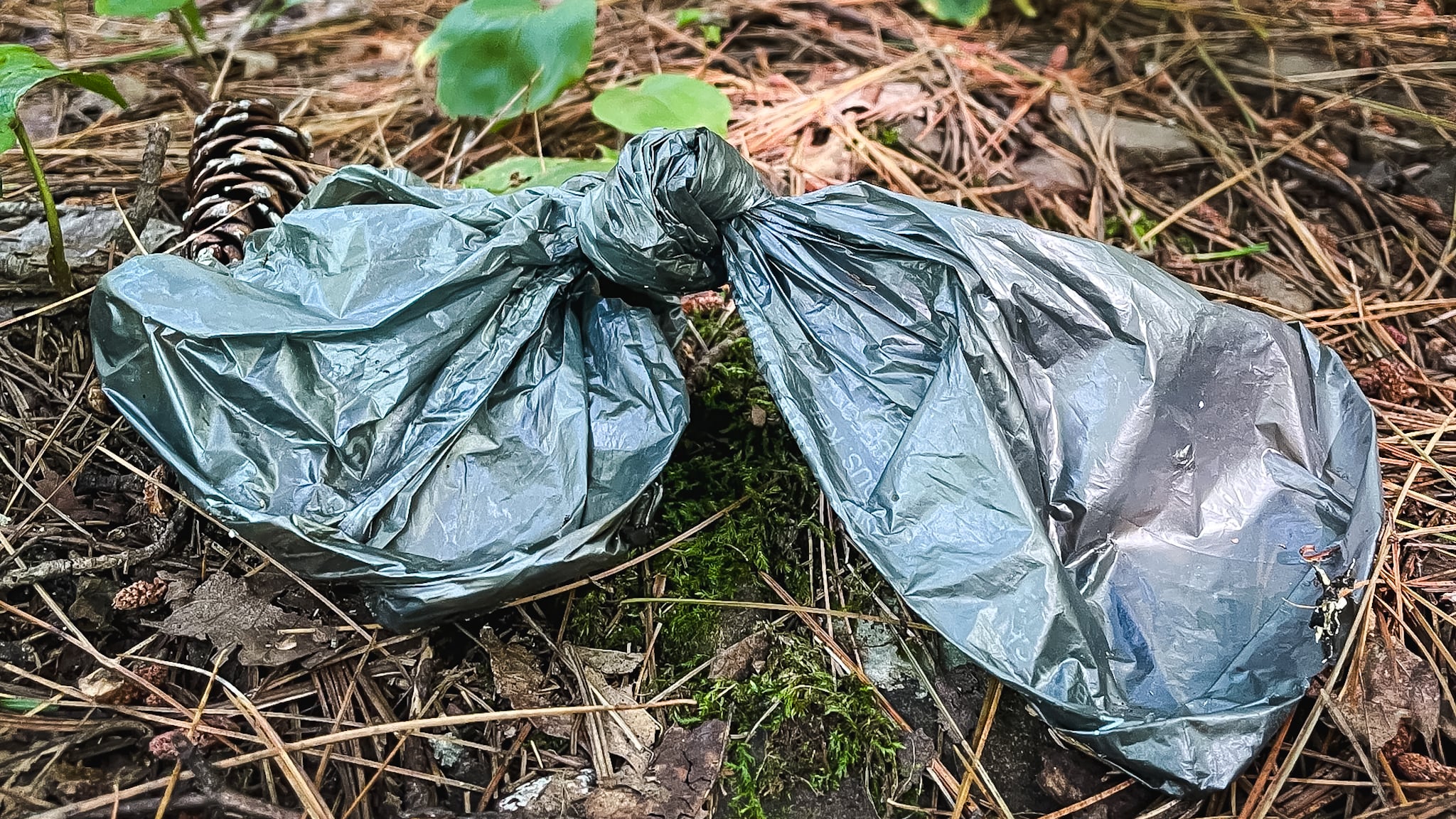Disclosure: This content may contain affiliate links. Read my disclosure policy.
For those of us who cherish the unspoiled beauty of nature, a growing problem threatens to mar our outdoor time: the increasing number of dog poop bags on our trails.
Recently, I witnessed this firsthand during a hike with new friends. While they took the initial step of bagging their dog’s waste, they proceeded to hang their brightly colored dog poop bags from tree branches along the trail – not once, but three times. To pick up on the way out!
This behavior, coupled with allowing their dog to approach uncomfortable hikers, betrayed a deep lack of awareness about proper trail etiquette and stewardship.
Also: just ick.
This incident is not isolated. Trailheads in particular seem to be dropping grounds for sloppy dog owners.
As a former dog owner and long-time dog lover, I think all dog owners have a responsibility to do better for the environment, for our fellow hikers, and for the very essence of the outdoor experience we all seek to enjoy.
The Problem of Dog Poop Bags on Trails
The issue of dog waste on hiking trails is multifaceted, impacting both the environment and the social aspects of outdoor recreation.
Environmental Impact
Contrary to popular belief, dog waste is not a natural part of the ecosystem in most hiking areas. Unlike the scat of native wildlife, dog feces can introduce harmful bacteria, parasites, and excess nutrients into the environment. This can lead to water pollution, affect local plant life, and potentially harm native animal species. The Leave No Trace Center for Outdoor Ethics emphasizes that pet waste can throw the ecosystem’s balance out of equilibrium.
Get access to hyper-detailed trail guides, insider tips, and expert advice. Join a vibrant community of like-minded hikers, receive exclusive content, and embark on unforgettable outdoor adventures. Whether you’re a seasoned outdoor enthusiast or just starting out on your hiking journey, this website provides invaluable resources to help you explore the best trails in the Catskills, Adirondacks, Hudson Highlands, Berkshires, and beyond. Get access now to all content on this website instantly and enjoy unique supporter benefits.
Social Impact of Dog Poop Bags Left on Trails
Beyond the ecological concerns, dog waste significantly affects the experience of other trail users. The sight and smell of dog feces – bagged or not – can be off-putting and detracts from the natural beauty hikers seek. It’s a visual reminder of human (and canine) presence in what should be a pristine environment. Moreover, it can lead to conflicts between dog owners and other hikers, potentially souring relationships within the outdoor community.
Bagged Poop on Trails
Perhaps even more problematic than un-bagged waste is the growing trend of “bag and abandon”.
Dog owners who bag their pet’s waste but leave the plastic-wrapped package on the trail are, arguably, creating a new and much worse problem. These colorful dog poop bags are more visually intrusive than naked droppings and introduce non-biodegradable plastic into natural environments.
Even if the intention is to “pick it up later”—and how many forgotten bags have you come across lately?—this practice normalizes littering and often results in forgotten bags that will persist in the environment for years to come.
As one hiker aptly put it, “What good is it to shove them in the bag and leave them there? In fact, it’s probably worse because now you introduce a plastic container, whereas un-bagged they would’ve eventually composted.”
This growing issue calls for a reevaluation of our practices as dog owners and hikers. In the following sections, we’ll explore why this behavior is problematic, address common excuses, and provide practical solutions for responsible dog waste management on the trail.
BTW, you might also enjoy…
- ADK › Whiteface Mountain via Marble Mountain
- DANGER › 6 Feet Under? How Our Adirondack Hike Turned Deadly Serious (Substack)
- ADK › Hurricane Mountain Fire Tower
- CATSKILLS › Catskills Fire Tower Challenge 2025
- Follow › My Instagram @TotalCatskills
- Follow › My writing for Times Union

Why Leaving Dog Poop Bags on the Trail is Worse Than Not Bagging at All
Bagging dog waste only to leave it on the trail is a misguided attempt at responsible pet ownership that actually compounds the problem. Here’s why:
Visual Pollution
Plastic bags filled with dog waste are far more visually intrusive than un-bagged poop. While natural waste tends to blend with the environment, colorful plastic bags stand out starkly against the natural backdrop. As another hiker noted, “We are out there to enjoy nature, not look at bags of shit.” These bags become eyesores that detract from the very beauty people seek when venturing into nature.
Plastic Waste
By introducing plastic into the environment, we’re creating a long-term problem. Plastic bags can take hundreds of years to decompose, far longer than the waste itself. Even biodegradable bags require specific conditions to break down effectively, conditions rarely met in outdoor settings. This means that a well-intentioned act of bagging waste can actually lead to persistent pollution.
False Sense of Responsibility
Bagging waste and leaving it trailside creates a false sense of having done the right thing. Dog owners might feel they’ve taken a responsible step. However, this mindset often leads to forgotten bags and normalized littering. As one park ranger shared, “It’s a daily task to go around picking up people’s bagged dog waste… often hidden.”
Worse Environmental Impact
Ironically, bagged waste can have a more severe environmental impact than un-bagged waste. While neither is ideal, un-bagged waste will eventually decompose and be reabsorbed into the ecosystem. Bagged waste, on the other hand, creates a sealed environment that can preserve the feces and its harmful bacteria for much longer, potentially leaching into soil and water sources when the bag eventually degrades.
Perpetuating Bad Habits
When other hikers see bagged waste left on trails, it can inadvertently send the message that this behavior is acceptable. This can lead to more people adopting the practice, exacerbating the problem. As one Reddit user aptly put it…
“If you do this, do you not know that everyone else hates you?”
The Forgotten Bag Phenomenon
Despite good intentions, many “temporary” leavers forget to pick up their bags on the return journey. Changes in routes, weather conditions, or simply forgetting can all lead to these bags becoming permanent fixtures on the trail. This turns a temporary inconvenience into lasting pollution.
Carry it Out
In essence, while the impulse to bag dog waste is correct, the follow-through is crucial. Bagging without proper disposal ultimately creates more problems than it solves, undermining the very principles of environmental stewardship that many hikers hold dear. The solution isn’t to stop bagging – it’s to commit to carrying out whatever we carry in…
Proper Dog Waste Management on Trails
Here’s how to manage your dog’s waste effectively. Proper waste management begins before you even set foot on the trail.
- Bring more waste bags than you think you’ll need;
- Plan for a way to carry full bags comfortably for the duration of your hike;
- Research the trail to know if there are trash cans available or if you’ll need to pack out everything.
Carrying Out What You Carry In
This fundamental principle of outdoor ethics applies to dog waste as much as it does to other trash. Despite the inconvenience, it’s crucial to carry your dog’s waste out with you. Remember, temporarily littering is still littering, and it degrades the experience for other trail users.
Clever Transportation Methods for Dog Poop Bags
Thankfully, there are several strategies to make carrying dog waste more manageable:
- Dedicated Waste Carrier: Use a small, sealable container specifically for waste bags. An old Nalgene bottle can work well, as one hiker suggested: “Biggest game changer is to use an old Nalgene bottle and stick the bagged poop in there. Totally hides the smell for carrying poop long distances.”
- Odor-Blocking Techniques: Line a pocket of your pack with a trash bag, or use a dedicated dry bag. For extra odor protection, carry some coffee grounds or powdered bleach to sprinkle over the waste.
- Fanny Packs or Clip-on Bags: Some hikers use a separate fanny pack or a clip-on bag specifically for waste. This keeps the smell away from your main pack and is easy to access.
- Dog Backpacks: Make your dog carry their own waste! As one hiker shared, “I solved this issue for myself by getting a saddle-bag style harness for my dog. He poops, he carries it out. We both pack out our own poop.” This method not only solves the carrying problem but can also provide exercise and a sense of purpose for your dog.
Remember, the goal is to make carrying out waste as easy and odor-free as possible. With a little creativity and the right equipment, it’s entirely manageable to keep both the trail and your hiking experience clean and enjoyable.
By adopting these practices, we not only maintain the cleanliness and beauty of our trails but also set a positive example for other hikers and dog owners. Proper waste management is a small act that has a big impact on preserving our natural spaces for everyone to enjoy.

All Your Excuses are Dogshit Too
Despite the clear reasons for properly managing dog waste, some hikers still find excuses to avoid this responsibility. Let’s address some of these common justifications:
“I’ll pick it up on the way back”
This is perhaps the most common excuse for leaving bagged waste on the trail. It’s problematic for several reasons:
- You might forget or be unable to find the bag on your return.
- Other hikers still have to see and smell the waste in the meantime.
- It normalizes the behavior of leaving waste behind.
As one hiker pointed out, “Sometimes you forget. Or it gets dark and you can’t find your goodie bag. Or you hike a loop and return on a different trail.” The safest and most considerate approach is to carry it with you from the start.
“It’s natural/other animals do it”
While it’s true that wild animals defecate in nature, domestic dog waste is different:
- Dog food often contains ingredients not found in the natural diet of wild animals.
- The concentration of dog waste in popular hiking areas is much higher than that of wild animal scat.
- Dog waste can spread diseases not typically found in the local ecosystem.
As one recent article states, “Mind you, I’m not condoning this sort of neglect either. And forget the ‘other animals poop outside!’ nonsense—deer and coyotes are native, your pup isn’t.”
“It’s too inconvenient to carry”
Carrying dog waste can be unpleasant, of course, but it’s a necessary part of responsible dog ownership. Consider:
- The inconvenience to you is temporary; the impact on the environment and other hikers lasts much longer.
- There are many solutions to make carrying waste easier and less smelly (as discussed in the previous section).
- If you’re unwilling to deal with your dog’s waste, it might be better to leave your dog at home for that particular hike.
As one hiker put it, “If you can jerry-rig a broken tent pole or treat a sprained ankle, surely you can find a way to transport a bag of poo with you until it can be disposed of.”
“It will decompose anyway”
While un-bagged waste will eventually decompose, there are several issues with this lazy “logic”:
- It can take a long time to fully decompose, during which it remains a nuisance and potential health hazard.
- Bagged waste in plastic takes even longer to break down.
- Even during decomposition, it can spread harmful bacteria and parasites.
Remember, the goal of hiking is often to enjoy unspoiled nature. Every piece of waste left behind detracts from this experience for others.
Call to Action
As responsible dog owners and outdoor enthusiasts, we must:
- Commit to always picking up after our dogs and carrying out the waste;
- Educate fellow dog owners about proper waste management techniques;
- Lead by example, demonstrating responsible dog ownership on trails;
- Support local initiatives to provide waste disposal facilities at trailheads;
- Participate in trail clean-up events to help maintain our natural spaces.
Remember, the joy of hiking with our dogs comes with the responsibility of minimizing our impact. Let’s commit to keeping our trails clean, our fellow hikers happy, and our environment healthy.
The next time you hit the trail with your four-legged friend, be prepared, be responsible, and leave no trace—not even a colorful dog poop bag hanging from a tree branch. Our trails, our fellow hikers, and our dogs will thank you for it.

Frequently Asked Questions About Dog Poop Bags on the Trail
- What to do with dog poop bags while hiking? Carry them with you until you reach a proper disposal bin. Use a sealed container or dedicated bag to minimize odor and inconvenience.
- Why do people leave dog poop bags on the ground? Often due to the intention to “pick it up later” on the return trip, or simple laziness and unwillingness to carry it.
- Is it okay to leave dog poop in the woods? No, it’s never okay. It can harm the local ecosystem and is unpleasant for other hikers.
- Why do people leave dog poop bags in trees? Usually to make them easier to spot and retrieve on the way back, or to keep them off the ground. This practice is still harmful and unsightly.
- Why pick up dog poop on trails? To preserve the natural environment, prevent the spread of diseases, and maintain a pleasant experience for other hikers.
- Are dog poop bags bad for environment? If left behind, yes. Even biodegradable bags can take a long time to decompose in natural settings.
- Is it bad for the environment to leave dog poop? Yes, it can introduce harmful bacteria and parasites, and excess nutrients that disrupt local ecosystems.
- Is dog poop toxic to wildlife? It can be. Dog poop can contain parasites and bacteria that are harmful to wildlife if ingested.
Read More
Get full access…
Get instant access to the full version of this site and enjoy great supporter benefits: full galleries, full trail notes, early access to the latest content, and more.
Hot on the website right now…
Follow for more…
Follow my @TotalCatskills content on Instagram for regular hiking inspo and safe, inclusive community.

